#NGC 7172
Photo

HCG 90 // Marco Lorenzi
#astronomy#astrophotography#galaxy group#HCG 90#galaxy#spiral galaxy#elliptical galaxy#interacting galaxies#NGC 7172#NGC 7173#NGC 7174#NGC 7176#piscis austrinus
222 notes
·
View notes
Text

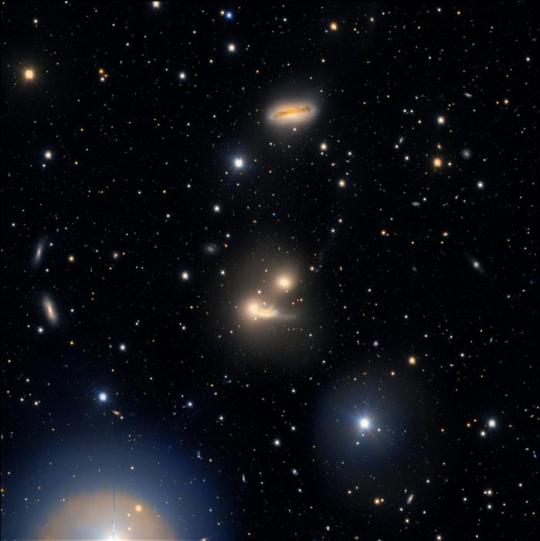
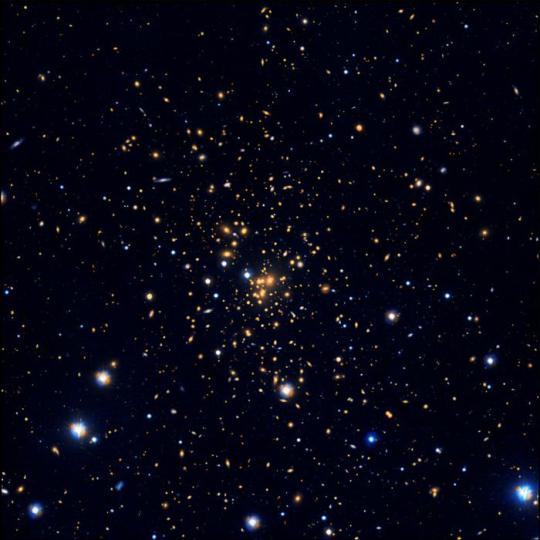
A triumph of galaxies in three new images from the VST
Distant, far away galaxies. Interacting galaxies, whose shape has been forged by the mutual gravitational influence, but also galaxies forming groups and clusters, kept together by gravity. They are the protagonists of three new images released by the VLT Survey Telescope (VST).
VST is an optical telescope with a 2,6 diameter mirror, entirely built in Italy, that has been operating since 2011 at the European Southern Observatory’s (ESO) Paranal Observatory in Chile. Since 2022, the telescope has been fully managed by INAF through the National Coordination Centre for VST, based at the INAF premises in Naples. VST is specialised in observing large areas of the sky thanks to its wide field camera, OmegaCAM, an actual “cosmic wide-angle lens” able to capture, in each shot, one square degree of the sky, a portion of the celestial vault twice as large as the full Moon’s apparent diameter on each side. Besides images for astrophysics research, spanning from stars to galaxies all the way to cosmology, in the past year the telescope has conducted a new programme dedicated to the general public, observing nebulae, galaxies and other iconic objects during some full Moon nights, when the brightness of our natural satellite disturbs the collection of scientific data. More images will be published in the coming months.
“Besides scientific research, one of the goals of the VST Centre is to disseminate scientific knowledge and to share the wonders of the Universe with the general public. We especially wish that young people can discover and nurture their interest in astrophysics through these amazing images”, notes Enrichetta Iodice, INAF researcher in Naples and responsible for the national Coordination Centre for VST.
One of the three new images portrays ESO 510-G13, a curious lenticular galaxy about 150 million light years from us, in the direction of the Hydra constellation. The central bulge of the galaxy stands out. The dark silhouette of the dust disk, seen from the edge, crosses the bulge, obscuring part of the light. The disk’s distorted shape, vaguely resembling an upside-down S, indicates the turbulent past of ESO 510-G13, which may have acquired its current appearance following a collision with another galaxy. In the lower right corner, among the many stars of the Milky Way scattered across the image, a pair of spiral galaxies about 250 million light years from us are also visible. Zooming into the image, many more galaxies appear, even at greater distances, as small spots of light elongated among the many dots in the background.
The second image shows a small group of four galaxies, called Hickson Compact Group 90 (HGC 90), which is about 100 million light years away from Earth, towards the Piscis Austrinus constellation. The two round, bright spots near the image centre are the elliptical galaxies NGC 7173 and NGC 7176. The bright streak that bifurcates and connects these two galaxies is the third member of the group, the spiral galaxy NGC 7174: its curious shape indicates the ongoing interaction between the three celestial bodies, which has stripped their stars and gas, mixing up their distribution. A halo of diffuse light envelops the three galaxies. The fourth galaxy belonging to the group, NGC 7172, visible in the upper part of the image, does not seem to participate in this celestial dance: its core, crossed by dark clouds of dust, hides a supermassive black hole that has been actively devouring the surrounding material. The HGC 90 quartet of galaxies is embedded in a much larger structure, including dozens of galaxies, some of which are visible in this image.
The third image shows a much richer and even more distant grouping of galaxies: the Abell 1689 galaxy cluster, which can be observed in the direction of the Virgo constellation. Abell 1689 contains more than two hundred galaxies, mostly visible as yellow-orange blobs, whose light has travelled for about two billion years before reaching the VST. The enormous mass, including enormous quantities of hot gas and of the mysterious dark matter in addition to the galaxies, deforms space-time in the vicinity of the cluster. Therefore, the cluster acts as a “gravitational lens” on more distant galaxies, amplifying their light and producing distorted images, much like what a magnifying glass does. Some of these galaxies can be spotted as dots and tiny, slightly curved lines, especially around the cluster's central regions.
TOP IMAGE....ESO 510-G13, a curious lenticular galaxy about 150 million light years from us, in the direction of the Hydra constellation. Credit INAF/VST. Acknowledgment: M. Spavone (INAF), R. Calvi (INAF)
CENTRE IMAGE....A small group of four galaxies, called Hickson Compact Group 90 (HGC 90), which is about 100 million light years away from Earth, towards the Piscis Austrinus constellation. Credit INAF/VST/VEGAS, E. Iodice (INAF). Acknowledgment: M. Spavone (INAF), R. Calvi (INAF)
LOWER IMAGE....The Abell 1689 galaxy cluster, which can be observed in the direction of the Virgo constellation. Credit INAF/VST. Acknowledgment: M. Spavone (INAF), R. Calvi (INAF)
3 notes
·
View notes
Photo
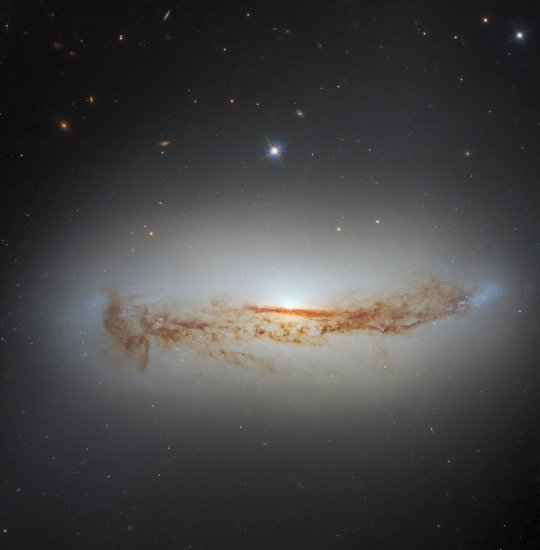
Dusty Spiral
64 notes
·
View notes
Text
हबल धूल के पीछे छिपे सुपरमैसिव ब्लैक होल को पकड़ लेता है
हबल धूल के पीछे छिपे सुपरमैसिव ब्लैक होल को पकड़ लेता है
नासा के हबल टेलीस्कोप, जिसने वैज्ञानिकों को अंतरिक्ष के कुछ अद्भुत पहलुओं की खोज करने में मदद की, ने गहरे धूल के टेंड्रिल के पीछे एक सक्रिय ब्लैक होल के एक आश्चर्यजनक दृश्य को कैप्चर किया है। ब्लैक होल सर्पिल आकाशगंगा NGC 7172 में स्थित है, जो प्राचीन, लेकिन छोटे नक्षत्र पिसिस ऑस्ट्रिनस में पृथ्वी से लगभग 110 मिलियन प्रकाश वर्ष दूर स्थित है। गहरे रंग की धूल आकाशगंगा के केंद्र से होकर गुजरती है,…

View On WordPress
0 notes
Text
Hubble sees a galaxy with an active black hole
Hubble sees a galaxy with an active black hole
Credit: ESA/Hubble & NASA, DJ Rosario, A. Barth; Acknowledgments: L.Shatz
This image from the NASA/ESA Hubble Space Telescope reveals a trail of dark dust passing through the core of spiral galaxy NGC 7172. The galaxy is located about 110 million light-years from Earth in the constellation of Pisces Ostrinus. A lane of dust burrowing its way through NGC 7172 obscures the galaxy’s luminous core,…

View On WordPress
0 notes
Text
C’è più di quello che si vede
C’è più di quello che si vede
Bande di polvere scura possono essere viste attraversare il cuore della galassia a spirale NGC 7172 in questa immagine del telescopio spaziale Hubble della NASA/ESA. La galassia si trova a circa 110 milioni di anni luce dalla Terra nella costellazione del Pesce Australe. La corsia di polvere che attraversa NGC 7172 – che in questa immagine è vista di lato – oscura il cuore luminoso della…
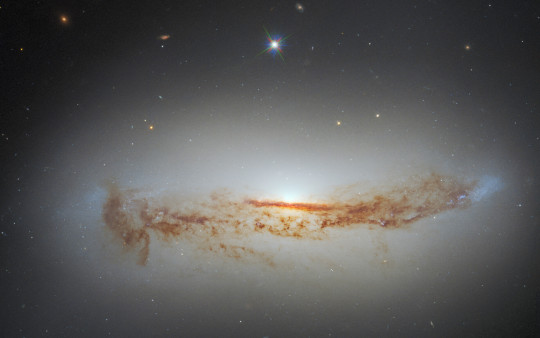
View On WordPress
0 notes
Text
The obscured active nucleus of NGC 7172 as seen by NuSTAR. (arXiv:1808.08457v2 [astro-ph.HE] UPDATED)
We analyse the properties of the X-ray emission from Seyfert 2 NGC 7172 which are based on the 32 ks observational data from NuSTAR in 2014. This source showed a constant Compton-thin obscuration $N_{H}\approx 8\cdot 10^{22} cm^{-2}$, which is similar to that observed by XMM-Newton, Suzaku, ASCA and BeppoSAX over past 30 years. We revealed the presence of a moderate reflection component with <R>~0.44 and a narrow FeK{\alpha} line with $67^{+13}_{-14}$ eV. The applied numerical models of torus confirmed the Compton-thin type of the Seyfert nucleus and allowed us to obtain an estimate of the torus opening angle ${\Theta}_{t}\sim59\deg$ and inclination ${\Theta}_{i}\sim61\deg$. Using the observation data of previous observation, we demonstrate also the long-term variability of intrinsic luminosity $L_{intr}$(2-10 keV) almost by order and EW $FeK_{\alpha}$ by factor $\sim4$ on a timescale of $\sim12$ years, that coincides to the distance of $d\sim$3.7 pc between central source and reprocessing medium. Such changes of intrinsic luminosity without changes in $N_{H}$ value indicate the variability of a central source. In the same time the spectral analysis results with the presence of the lag between variability of intrinsic luminosity $L_{intr}$(2-10 keV) and EW $FeK_{\alpha}$, as well as a behaviour of intensity $I_{FeK_{\alpha}}$ of the line are in agreement with the scenario, where observed $FeK_{\alpha}$ line is generated in a distant gas-dust torus.
from astro-ph.HE updates on arXiv.org https://ift.tt/2PGLhZZ
0 notes
Photo
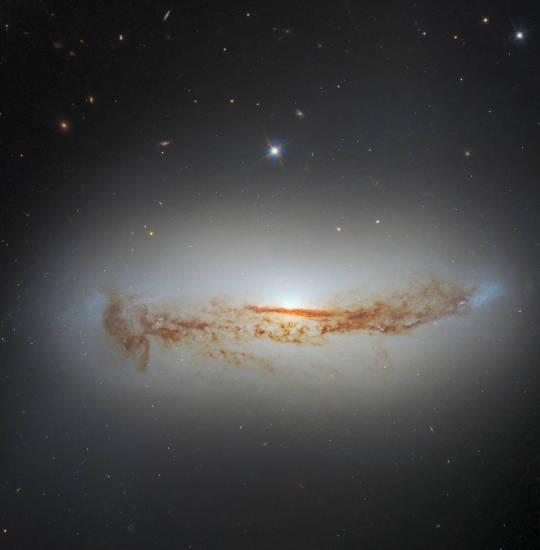
Hubble Views a Galaxy with an Active Black Hole This image from the NASA/ESA Hubble Space Telescope reveals tendrils of dark dust threading across the heart of the spiral galaxy NGC 7172. The galaxy lies approximately 110 million light-years from Earth in the constellation Piscis Austrinus. The lane of dust threading its way across NGC 7172 is obscuring the luminous heart of the galaxy, making NGC 7172 appear to be nothing more than a normal spiral galaxy viewed from the side. When astronomers inspected NGC 7172 across the electromagnetic spectrum they quickly discovered that there was more to it than meets the eye: NGC 7172 is a Seyfert galaxy – a type of galaxy with an intensely luminous active galactic nucleus powered by matter accreting onto a supermassive black hole. This image combines data from two sets of Hubble observations, both proposed to study nearby active galactic nuclei. The image also combines data from two instruments – Hubble’s Advanced Camera for Surveys and Wide Field Camera 3.
2 notes
·
View notes